Galaxies
A galaxy is a family of stars, held together by their mutual gravitational
attraction, and with a distinct identity separating it from other galaxies.
Galaxies cover a huge range of size and mass as well as exhibiting a variety
of structures and properties. The smallest galaxies known are relatively
nearby dwarf galaxies containing only 100,000 stars, fewer than in a typical
globular cluster. At the other end of the scale, the most massive galaxy
known, the giant elliptical M87, contains 3,000 billion solar masses, about
15 times more than our own Galaxy.
Most galaxies can be categorized into a number of broad morphological types.
Spiral galaxies are disc-shaped, with a central bulge, from which spiral
arms appear to wind outwards. In barred spirals, a bar of stars extends out
from the bulge and the arms appear to be attached to the ends of the bar.
Spiral galaxies contain very luminous young stars and significant amounts of
interstellar material concentrated in the arms.
Most of the conspicuous galaxies in the sky are spirals, but the most
numerous type is the elliptical galaxy. Both the smallest and largest
galaxies are of this kind. They are thought to consist entirely of old stars
with relatively little interstellar material.
The third main group is that of irregular galaxies, which are neither spiral
nor elliptical. These account for up to a quarter of all known galaxies. At
visible wavelengths, irregular galaxies show no particular circular symmetry
and look chaotic.
1 2 2 3 3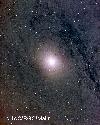
Description: The nearest comparable spiral galaxy to the Milky Way is
M31 (NGC 224), the great galaxy in Andromeda. It is visible to the
unaided eye and has been known as a curious hazy patch since
ancient times. Only in the last 75 years has its nature as a distant
city of stars like the Milky Way become apparent. Image 3 shows
the central part of M31, the huge mass
of stars that are in orbit around its nucleus. Silhouetted against
this starry background are tangled sheets and curtains of dust,
very reminiscent of dust clouds we see in our own galaxy. At the heart of
M31 is a tiny, bright nucleus, seen to be slightly elongated. Hubble Space
Telescope pictures show the nucleus to be a double structure, possible the
remains of the nucleus of another galaxy which has now been almost
completely absorbed in M31. Around the binary nucleus swirls a huge cloud of
mostly old, faint stars. These stars are unresolved on the plates that were
used to make picture 3 and have been removed by a photographic process known
as 'unsharp masking'.
Copyright: Malin-IAC-RGO.
Technical information: These 3 pictures are 3-colour photographic
compositions from the Isaac Newton
Telescope.
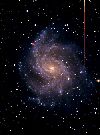
Description: NGC6946. NGC 6946 (Arp 29) is a face-on SAB(rs)cd galaxy
in the constellation Cygnus. This classification refers to the
presence of a small core with multiple well-defined arms (cd), with a
poorly-developed bar across the middle (AB) and
an inner confused ring (rs). Nearly twenty million light years from Earth,
it is over seventy thousand light years across.
Credit: Simon Driver.
Technical information: Image taken using the Wide Field Camera on the
Isaac Newton Telescope on 12th June 1999.
Available formats: [ JPEG (510 K) | TIFF (1,275 K) ]
1  2 2 3 3
Description: M33 Galaxy. This
galaxy is one of the finest examples of a spiral galaxy in the sky and is
about one degree across. The galaxy is a member of the 30 or so galaxies of
the Local Group and is close enough - about 2.5 million light years - for us
to study the anatomy of a galaxy in great detail. Many individual bright
stars pepper the delicate spiral arms which are in turn sprinkled with pink
star-forming regions. Several of the clumps of bright stars and their
associated nebulae are bright enough to have been catalogued as separate
objects.
Credits: Image 1 is courtesy Romano Corradi.
Image 2 is courtesy
Simon Tulloch and Nik Szymanek.
Image 3 is copyright Malin-IAC-RGO.
Technical information: Image 1 was obtained with the mosaic CCDs of
the Wide Field Camera at the INT. The image is a composition of frames taken
in three narrow bands: the green colour represents the galaxian emission in
[OIII] nebular line, red is the H-alpha hydrogen emission and blue is mainly
stellar light taken through a continuum filter centred at 555.0 nm
(Stromgren Y). In only one observing night, and with two positionings of the
telescope, it was possible to cover the whole galaxy which has a size of
approximately one degree in the sky. More information: Another View of M33 - ING Newsletter
article.
Image 2 is a CCD true-colour
composition achieved with the 2 detector WHT Prime Focus camera. Exposure
time was 10s.
Image 3 is a 3-colour photographic composition from the Isaac Newton
Telescope.
Available formats: Image 1: Landscape DIN-A4: [ JPEG (54 K) | TIFF (1,089 K) ]. Very large
format (480 mm wide): [ PDF (2,329) | TIFF (37,987 K) ].
Image 2: [ JPEG (417 K) | TIFF (2,761 K) ]

M51 galaxy, known as The Whirlpool Galaxy, is a bright spiral galaxy
fairly close to us (7.5 Megaparsecs = 25 million light years). To the north of M51, at the bottom of the picture, is a companion
galaxy which is being disrupted by the gravitational tidal forces of the
main galaxy.
Credit: Peter Bunclark.
Technical information: Shown here is a true-colour picture using BVR imaging on the
INT wide field camera. This picture was generated from two-minute
exposures. The field size of this single Loral CCD
image is 12.6 arcminutes.
Available formats: JPEG (69 K)

Description: The galaxy Dwingeloo 1. This is a barred spiral galaxy, probably one
of the largest and nearest galaxies, but undiscovered until 1994. This
is because it is hidden behind the disk of our own galaxy, the Milky Way
- as a result more than 99% of its light is absorbed by dust in our galaxy
before it reaches us. The galaxy was discovered using a combination of
radio observations and INT CCD imaging.
Credit: G. S. Hughes, & S. Maddox.
Technical information: Shown here is a true colour picture
using VRI CCD imaging on the INT.
Available formats: JPEG (58 K)

Description: M100 (NGC 4321). This is a barred galaxy in the Virgo
cluster. New infrared and optical
images taken with the WHT suggest that this "normal" spiral galaxy hides
a barlike structure in its heart.
Credit: Johan Knapen, John Beckman,
Soledad del Río and María J. Sempere.
Technical information: True colour image obtained using BVI CCD
imaging on the INT.
Available formats: JPEG (26 K)

Description:
NGC 6822 or Barnard's galaxy. NGC 6822 is one of the nearest galaxies and is
thus a member of the Local Group. The galaxy seems to be without symmetry and is
classified as an irregular. At one end of a prominent bar a few clouds of
glowing gas can be seen; at the other, bright bluish stars are scattered out
into what appears to be the first signs of a straggling spiral arm.
The fact that this
galaxy is near enough for us to be able to resolve a large number of its
individual stars makes it possible to study the star formation history
based on colour-magnitude diagrams.
Credit: Carme Gallart and Antonio Aparicio.
Technical information: This image was obtained using CCD imaging on
the Isaac Newton Telescope. Exposure
times were 900s in I, 900s in R, 1000s in V and 1200s in B.
Available formats: BMP (2,463 K). These are true-colour pictures of the region
in the centre of the galaxy (gifs): RVB
IRV IRB
IVB.
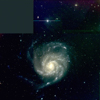
Description: M101 galaxy, the Pinwheel galaxy. M101 is one of the most prominent Grand Design spirals in
the sky. While quite symmetric visually, it is of
remarkable unsymmetry, its core being considerably displaced from the center
of the disk. Halton Arp has included
M101 as No. 26 in his Catalogue of Peculiar Galaxies as a "Spiral with One
Heavy Arm".
Credit: Peter Bunclark.
Technical information: The picture was produced by composing three,
two-minute, exposures taken through R, V and B Harris photometric
filters, approximating the normal red, green and blue passbands. The area
shown is approximately 30x30 arc minutes, ie
the full field of the Wide-Field Camera CCD mosaic at the prime-focus of the
Isaac Newton Telescope.
Available formats: GIF (131 K)
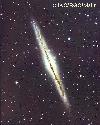
Description: NGC 891, an edge-on spiral galaxy. If we could view the
Milky Way from a distance of aboput 30 million light years it would look
something like NGC 891. But galaxies that look like this are quite rare
because the chance alignment of the thin disk of a spiral galaxy with our
line of sight is unusual. A few degrees either side of its orientation and
NGC 891 would be just another highly inclined spiral galaxy.
From this unusual vantage point we can see in NGC 891 the surprising
narrowness of the obscuring dust lane, a dark slightly irregular band across
the galaxy. We also see that it is yellowish, confirming that it is dust,
which absorbs blue light, as in the Milky Way. Also similar to the Milky Way
is the prominent central 'bulge' corresponding to the rich star clouds in
Sagittarius.
Copyright: Malin-IAC-RGO.
Technical information: Photographic 3-colour composition from the
Isaac Newton Telescope.

Description:M95 Galaxy or NGC 3351. M95 was one of the galaxies in the key project of the
Hubble Space
Telescope for the determination of the Hubble constant: the HST was
employed to look for Cepheid variables and thereby determine this
galaxy's distance.
It is a barred spiral of type SBb, or SB(r)ab according to de Vaucouleurs'
classification, with nearly circular arms. Alan Sandage, in the Hubble Atlas of Galaxies, calls it a "typical ringed
galaxy".
Credit: Nial Tanvir.
Technical information: This picture was taken with the LDSS-2
instrument in imaging mode, on the WHT.Images taken in three filters (red,
green and blue) were combined to create this "true colour" picture.
Available formats: GIF (115 K)
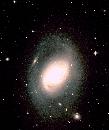
Description:M 96 or NGC 3368 Galaxy. M96 is the brightest member of the Leo I
group of galaxies, which is therefore also called the M96 group.
Its distance was determined to be about 41 million light years (after
corrections for the distance scale which are implied by the
results of ESA's Hipparcos satellite) by Nial R. Tanvir with the Hubble
Space Telescope by observing Cepheid variables.
Interpolated with the HST result of 35.5 million light years for its
neighbor M95, a value of 38 million light years can be adopted for the
group.
Credit: Nial Tanvir.
Tecnical information: True-colour CCD image obtained with the Isaac
Newton Telescope.
Available formats: JPEG (537 K)

Description: NGC 1300 galaxy. NGC 1300 is a classic barred spiral
galaxy. It is 17 Mpc away and relatively face-on, with an inclination of
about 35
degrees. Because of it's size and inclination it is well-suited for a number
of studies.
Credit: J. Cepa y A. M. Varela.
Technical description: True-colour CCD images from B, V and I imaging
on the Isaac Newton Telescope.
Available formats: GIF (243 K)

Description: The Leo triplet of galaxies, M105, NGC3384 and
NGC3389.
Credit: Nial Tanvir.
Technical information: CCD images obtained on the Isaac Newton
Telescope.
Available formats: JPEG (72 K)
|



 2
2 3
3


